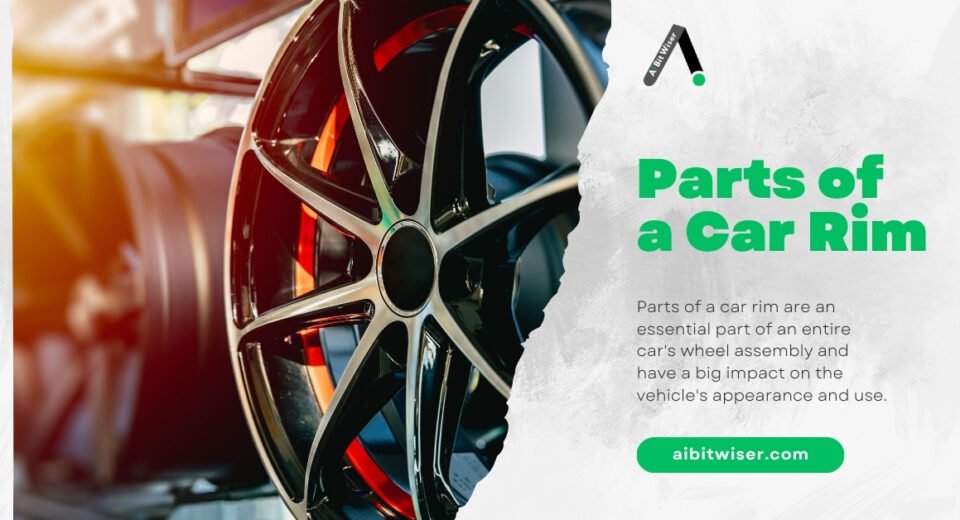Parts of a Car Rim: Understanding the Components and Functions
Parts of a car rim are an essential part of an entire car’s wheel assembly and have a big impact on the vehicle’s appearance and use. The outside edge of the wheel, or rim, is what secures the tire in place and promotes maximum performance. Car fans and mechanics alike may better understand the intricacy and significance of an automobile rim by being aware of its many components. The Structure of a Car Rim The automobile rim is made up of many essential components, each of which has a distinct purpose. The barrel, the outer lip, the inner lip, and the drop center make up the rim’s main structural components. The cylindrical portion of the rim that serves as the tire mounting surface is called the barrel. Its construction ensures stability and endurance by withstanding the forces applied by both the tire and the road. When the tire is installed, the visible portion of the rim is known as the outside lip. It is essential to the wheel’s overall look and frequently has elaborate finishes and patterns. Conversely, the edge of the rim facing the interior of the car is known as the inner lip. The Drop Center and Bead Seat The drop center is one of an automobile rim’s most important components. This is the rim’s centrally located recessed section, which makes tire mounting and removal simpler. Installing a tire is made easier and more effective by the drop center, which offers the space needed to put the tire over the rim. The bead seats are next to the drop center. When the wheel is installed on the rim, these are the areas the places where the tire beads settle. To keep air from escaping and guarantee that the tire stays firmly in place, the bead seats are made to form a tight seal with the tire. Tire pressure maintenance and general safety depend on well-designed bead seats. The Flanges and Humps The raised edges on either side of the rim that aid in maintaining the tire’s position are called flanges. In order to prevent the tire from slipping off the rim while in use, they give the tire beads more support. In order for the rim to sustain the stresses applied when driving, the flanges also add to the rim’s overall strength and stiffness. Apart from the flanges, humps are a common feature on wheels. These are little raised patches that give the tire more security and are situated close to the bead seats. The humps aid in preventing the tire from sliding laterally on the rim, particularly while traveling quickly or when the car is being abruptly maneuvered. To keep the stability and functionality of the system, this additional security is essential. The Valve Hole The valve’s hole on an automobile rim is another crucial component. This is the little rimmed aperture where the valve stem is placed. The valve stem is an essential part in preserving proper tire pressure because it permits the tire to be inflated and deflated. Accurate machining of the valve hole must be performed to guarantee a tight fit for the valve stem, stopping leakage & guaranteeing dependable operation. The Importance of Rim Design and Material An automobile rim’s performance and longevity are strongly affected by its design & material. A variety of materials, including alloys, steel, & aluminum, can be used to make rims. Each material has unique advantages and downsides that impact the rim’s strength, weight, & price. Steel rims remain a common option for many cars because of their reputation for cost & durability. They are heavier than alloy or aluminum rims, though, and that may affect handling vehicle fuel economy. Contrarily, aluminum rims are also less costly and more resilient than steel rims, but they’re lighter and possess greater performance qualities. Alloy rims offer a combination of strength, weight, and cost by combining the advantages of aluminum and steel. They are frequently seen in luxury and high-performance automobiles, where both performance and looks are crucial. The overall functionality and look of the rim are also greatly influenced by its design, which includes the size and form of its component pieces. Conclusion: Parts of a Car Rim Anyone who works on or customizes automobiles must be aware of the components of an automobile rim. Every part of the rim, from the lips and barrel to the drop center and bead seats, is essential to guaranteeing the tire’s proper fit and longevity. For both auto fans and technicians, the rim’s design and material have a significant impact on its overall performance, durability, and weight. Understanding the subtleties of automotive maintenance and modification is made easier by realizing the significance and intricacy of car rims. FAQs on Car Wheels and Rims Q: What are the parts of a car wheel called? A: The main components of an automobile wheel are the valve stem, spokes (in some designs), hub, tire, and rim. The hub is the center component that attaches to the axle of the car, whereas the rim is the outside border that supports the tire. If there are spokes, they link the hub and rim and offer structural support. Q: What does a rim consist of? A: The barrel, outer lip, inner lip, drop center, bead seats, flanges, humps, and valve hole are some of the parts that make up a rim. For the wheel to operate at its best and the tire to be fitted securely, each component has a specific function. Q: What connects the rim to the car? A: The hub, which is fastened to the car’s axle, is what connects the rim to the vehicle. To ensure that the wheel is securely fastened to the vehicle, the hub usually features a center hole that fits over the axle and is fastened with bolts or lug nuts. Q: What holds a tire on a rim? A: Bead seats and flanges secure a tire to a rim. The flanges offer extra support to hold the tire in
















